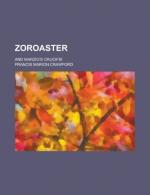The religion of the kingdom was of a most uncertain kind. So many changes had passed over the various provinces which made up the great empire that, for generations, there had been almost a new religion for every monarch. Cyrus, inclining to the idolatry of the Phoenicians, had worshipped the sun and moon, and had built temples and done sacrifice to them and to a multitude of deities. Cambyses had converted the temples of his father into places of fire-worship, and had burnt thousands of human victims; rejoicing in the splendour of his ceremonies and in the fierce love of blood that grew upon him as his vices obtained the mastery over his better sense. But under both kings the old Aryan worship of the Magians had existed among the people, and the Magians themselves had asserted, whenever they dared, their right to be considered the priestly caste, the children of the Brahmins of the Aryan house. Gomata—the false Smerdis—was a Brahmin, at least in name, and probably in descent; and during his brief reign the only decrees he issued from his retirement in the palace of Shushan, were for the destruction of the existing temples and the establishment of the Magian worship throughout the kingdom. When Darius had slain Smerdis, he naturally proceeded to the destruction of the Magi, and the streets of Shushan ran with their blood for many days. He then restored the temples and the worship of Auramazda, as well as he was able; but it soon became evident that the religion was in a disorganised state and that it would be no easy matter to enforce a pure monotheism upon a nation of men who, in their hearts, were Magians, nature-worshippers; and who, through successive reigns, had been driven by force to the adoration of strange idols. It followed that the people resisted the change and revolted whenever they could find a leader. The numerous revolutions, which cost Darius no less than nineteen battles, were, almost without exception, brought about in the attempt to restore the Magian worship in various provinces of the kingdom, and it may well be doubted whether, at any time in the world’s history, an equal amount of blood was ever shed in so short a period in the defence of religious convictions.
Darius himself was a man who had the strongest belief in the power of Auramazda, the All-Wise God, and who did not hesitate to attribute all the evil in the world to Ahriman, the devil. He had a bitter contempt for all idolatry, nature-worship and superstition generally, and he adhered in his daily life to the simple practices of the ancient Mazdayashnians. But he was totally unfitted to be the head of a religious movement; and, although he had collected such of the priesthood as seemed most worthy, and had built them temples and given them privileges of all kinds, he was far from satisfied with their mode of worship. He could not frame a new doctrine, but he had serious doubts whether the ceremonies his priests performed were as simple and religious as he wished them to be.




